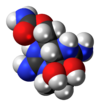石房蛤毒素
| 石房蛤毒素 | |||
|---|---|---|---|

| |||
| |||
| IUPAC名 (3aS-(3a-α,4-α,10aR*))-2,6-Diamino-4-(((amino-carbonyl)oxy)methyl)-3a,4,8,9-tetrahydro-1H,10H-pyrrolo(1,2-c)purine-10,10-diol | |||
| 识别 | |||
| CAS号 | 35523-89-8 | ||
| PubChem | 37165 | ||
| ChemSpider | 34106 | ||
| SMILES |
| ||
| InChI |
| ||
| InChIKey | RPQXVSUAYFXFJA-HGRQIUPRBO | ||
| ChEBI | 34970 | ||
| KEGG | C13757 | ||
| IUPHAR配体 | 2625 | ||
| 性质 | |||
| 化学式 | C10H17N7O4 | ||
| 摩尔质量 | 299.29 g·mol−1 | ||
| 若非注明,所有数据均出自标准状态(25 ℃,100 kPa)下。 | |||
石房蛤毒素(Saxitoxin ,STX)是一种极强的神经毒素,是已知毒性最强的麻痹性贝类毒素(PST)。
石房蛤毒素首次分离于帘蛤科的石房蛤体内,并由此得名。石房蛤毒素实际上是一些藻类和蓝细菌所合成,通过食物链聚集到贝类体内。已知自然存在结构相似的神经毒素有超过50种,统称为石房蛤毒素类,除了石房蛤毒素本身外,还有新石房蛤毒素 (NSTX)、膝沟藻毒素、脱氨甲酰基石房蛤毒素 (dcSTX)等。
自然存在
[编辑]自然界中,石房蛤毒素实际上是一些双鞭毛虫门下的藻类所合成的,如亚历山大藻、裸甲藻,以及淡水中的蓝细菌如鱼腥藻属、一些束丝藻属、拟柱孢藻、鞘丝藻、浮丝藻属等[1][2]。被贝类进食后,累积在滤食器官中。 此外,石房蛤毒素也曾在亚洲河鲀的一些物种和巴西的罗非鱼体内发现存在[3]。产自美国的野生河鲀,其体内石房蛤毒素浓度与产自南美[4]、日本[5][6]菲律宾和泰国的相似。河鲀体内累积另一种著名的神经毒素,即河鲀毒素。
有些被藻华所污染的贝类含有此毒素,误食导致中毒。很多常见的经济水产均可能受到污染,包括淡菜类、蛤蜊、生蚝和扇贝等。污染通常存在于温带海域,从美国西海岸到西欧、东亚、澳大利亚,新西兰和南非等地海域都有可能。如果检测到毒素存在,政府部门有时不得不采取捕捞禁令等措施以图控制中毒事件。
结构与合成
[编辑]石房蛤毒素的二盐酸盐是吸湿性的无定型固体。然而,其结构还是可以通过结晶衍生物的X射线晶体学确定。[7][8]石房蛤毒素氧化生成高荧光性的嘌呤衍生物,被用于检测分析。[9]
毒性
[编辑]中毒机理
[编辑]
石房蛤毒素是一种选择性的细胞膜钠离子通道阻滞剂。[13]它与神经元细胞膜上的钠离子通道结合,抑制钠离子通过细胞膜,从而阻止细胞电位的传导,最终导致瘫痪。
剂量
[编辑]对于豚鼠,肌肉注射的致死剂量约为5 μg/kg体重。小鼠的致死剂量与与给药途径有关为:腹膜内注射(LD50 = 10 μg/kg),静脉注射(LD50 = 3.4 μg/kg),口服(LD50 = 263 μg/kg)。人类经口服的LD50为5.7 μg/kg,换句话说,口服摄入0.57 mg的石房蛤毒素——一颗沙子大小的1/8,即可致命。注射的致死量约为0.6 μg/kg,是口服的十分之一。气溶胶吸入的致死剂量约为5 mg·min/m³。石房蛤毒素可经开放伤口进入人体,剂量约为50 μg。[14]
动物实验显示4-氨基吡啶有解毒作用,[15][16][17]不过无人体实验数据。
参考资料
[编辑]- ^ Clark R. F.; Williams S. R.; Nordt S. P.; Manoguerra A. S. A review of selected seafood poisonings. Undersea Hyperb Med. 1999, 26 (3): 175–84 [2008-08-12]. PMID 10485519. (原始内容存档于2011-08-11).
- ^ Landsberg, Jan H. The Effects of Harmful Algal Blooms on Aquatic Organisms. Reviews in Fisheries Science. 2002, 10 (2): 113–390. doi:10.1080/20026491051695.
- ^ Galvão, J. A.; Oetterer, M.; Bittencourt-Oliveira Mdo, M. D. C.; Gouvêa-Barros, S.; Hiller, S.; Erler, K.; Luckas, B.; Pinto, E.; Kujbida, P. Saxitoxins accumulation by freshwater tilapia (Oreochromis niloticus) for human consumption. Toxicon. 2009, 54 (6): 891–894. PMID 19560484. doi:10.1016/j.toxicon.2009.06.021.
- ^ Lagos, N. S.; Onodera, H.; Zagatto, P. A.; Andrinolo, D. ́O.; Azevedo, S. M. F. Q.; Oshima, Y. The first evidence of paralytic shellfish toxins in the freshwater cyanobacterium Cylindrospermopsis raciborskii, isolated from Brazil. Toxicon. 1999, 37 (10): 1359–1373. PMID 10414862. doi:10.1016/S0041-0101(99)00080-X.
- ^ Sato, S.; Kodama, M.; Ogata, T.; Saitanu, K.; Furuya, M.; Hirayama, K.; Kakinuma, K. Saxitoxin as a toxic principle of a freshwater puffer, Tetraodon fangi, in Thailand. Toxicon. 1997, 35 (1): 137–140. PMID 9028016. doi:10.1016/S0041-0101(96)00003-7.
- ^ Deeds, J. R.; Landsberg, J. H.; Etheridge, S. M.; Pitcher, G. C.; Longan, S. W. Non-Traditional Vectors for Paralytic Shellfish Poisoning. Marine Drugs. 2008, 6 (2): 308–348. PMC 2525492
 . PMID 18728730. doi:10.3390/md6020308.
. PMID 18728730. doi:10.3390/md6020308.
- ^ Bordner J.; Thiessen W. E.; Bates H. A.; Rapoport H. The structure of a crystalline derivative of saxitoxin. The structure of saxitoxin. Journal of the American Chemical Society. 1975, 97 (21): 6008–12. doi:10.1021/ja00854a009.
- ^ Schantz E. J.; Ghazarossian V. E.; Schnoes H. K.; Strong F. M.; Springer J. P.; Pezzanite J. O.; Clardy J. The structure of saxitoxin. Journal of the American Chemical Society. 1975, 97 (5): 1238–1239. doi:10.1021/ja00838a045.
- ^ Bates H. A.; Kostriken R.; Rapoport H. A chemical assay for saxitoxin. Improvements and modifications. Journal of Agricultural and Food Chemistry. 1978, 26 (1): 252–4. doi:10.1021/jf60215a060.
- ^ Tanino H.; Nakata T.; Kaneko T.; Kishi Y. A stereospecific total synthesis of d,l-saxitoxin. Journal of the American Chemical Society. 1997, 99 (8): 2818–9. doi:10.1021/ja00450a079.
- ^ Bhonde V. R.; Looper R. E. A stereocontrolled synthesis of (+)-saxitoxin. Journal of the American Chemical Society. 2011, 133 (50): 20172–4. doi:10.1021/ja2098063.
- ^ Fleming J. J.; McReynolds M. D.; Du Bois J. (+)-Saxitoxin: a first and second generation stereoselective synthesis. Journal of the American Chemical Society. 2007, 129 (32): 9964–75. PMID 17658800. doi:10.1021/ja071501o.
- ^ Huot, R. I.; Armstrong, D. L.; Chanh, T. C. Protection against nerve toxicity by monoclonal antibodies to the sodium channel blocker tetrodotoxin. Journal of Clinical Investigation. June 1989, 83 (6): 1821–1826. PMC 303901
 . PMID 2542373. doi:10.1172/JCI114087.
. PMID 2542373. doi:10.1172/JCI114087.
- ^ Patocka J; Stredav L. Price, Richard , 编. Brief Review of Natural Nonprotein Neurotoxins. ASA Newsletter (Applied Science and Analysis inc.). April 23, 2002, 02–2 (89): 16–23 [26 May 2012]. ISSN 1057-9419. (原始内容存档于2013-01-04).
- ^ Benton, B. J.; Keller, S. A.; Spriggs, D. L.; Capacio, B. R.; Chang, F. C. Recovery from the lethal effects of saxitoxin: A therapeutic window for 4-aminopyridine (4-AP). Toxicon. 1998, 36 (4): 571–588. PMID 9643470. doi:10.1016/s0041-0101(97)00158-x.
- ^ Chang, F. C.; Spriggs, D. L.; Benton, B. J.; Keller, S. A.; Capacio, B. R. 4-Aminopyridine reverses saxitoxin (STX)- and tetrodotoxin (TTX)-induced cardiorespiratory depression in chronically instrumented guinea pigs. Fundamental and Applied Toxicology. 1997, 38 (1): 75–88. PMID 9268607. doi:10.1006/faat.1997.2328.
- ^ Chen, H.; Lin, C.; Wang, T. Effects of 4-Aminopyridine on Saxitoxin Intoxication. Toxicology and Applied Pharmacology. 1996, 141 (1): 44–48. PMID 8917674. doi:10.1006/taap.1996.0258.


